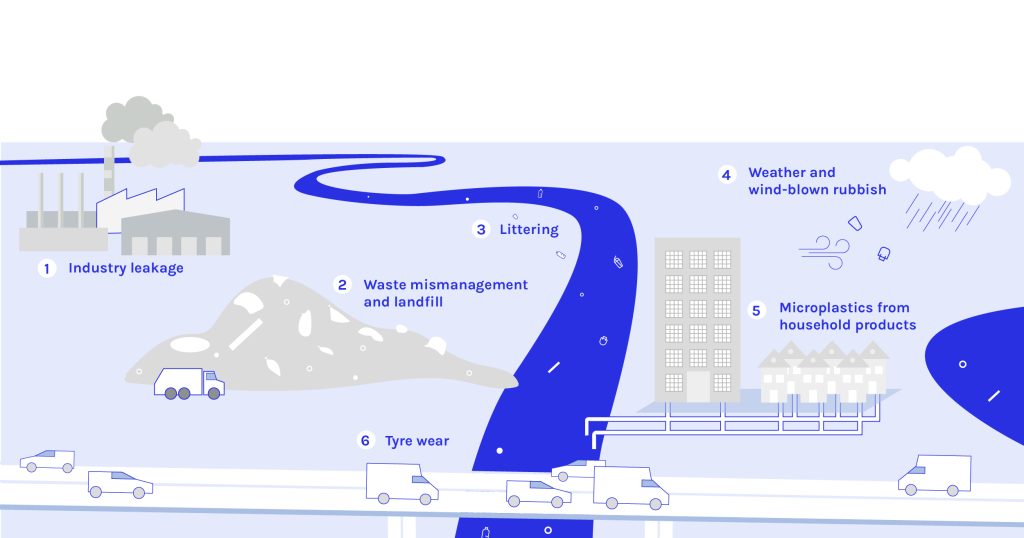As much as 80% of the plastic found in our oceans is transported from the land by rivers[i]. Even more, plastic may be trapped in our rivers, never reaching the seas. But how does plastic get into rivers in the first place?
Every minute the equivalent of one rubbish truck full of plastic reaches our ocean[ii], with plastic bags, bottles and food containers being the plastic items most commonly found in our waterways[iii]. There is mounting evidence of the impact of plastic pollution on human health and the marine environment. The most effective way to tackle the issue is to prevent plastic from ever reaching our rivers and oceans. That requires us to understand the many ways plastics and litters enters our environement, from direct dumping to tyre wear and weather.
How does plastic get into rivers?

Waste mismanagement and landfill
Rich industrialised nations produce up to 10 times as much plastic waste per person per day[iv] as opposed to countries in the Global South. While much of this may be collected, less than 10% of the plastic ever produced has been recycled[v]. The remainder is destined for incineration or landfill.
Not all of the plastic stays at the landfill site. Wind and weather can transport it to our rivers. If it is buried in the landfill, then toxic chemicals can leach out of the plastic, polluting the soil and groundwater. Incineration can release toxic chemicals into the atmosphere.
Plastic waste that is marked as ‘recyclable’ is frequently exported. Over 1 million tonnes of plastic waste was exported by the EU to countries in the Global South in 2022, an increase of 70% since the year 2000, avoiding the need to invest in expensive recycling facilities[vi].
Though plastic use is lower in developing countries, most waste – including what is exported by industrialised nations – ends up on the side of the road, in open dumps or is incinerated. As a result, 22% of all plastic waste is being mismanaged and 49% is sent to landfill [vii].
Industrial leakage
Before products ever even make it to market, plastic can leak out from poorly managed industrial processes, often located along rivers.
Plastic is produced from pellets about the size of a lentil. If not managed properly, they can leak out during production or during transportation. The European Commission estimates that 167,000 tonnes of plastic pellets leak out of industries in the European Union every year[viii].
Much of this is avoidable through good pellet handling processes, supported by employee training on best practices.
Littering
Littering is one cause – whether dropping in the street or larger scale illegal dumping of waste. Litter may be dropped voluntarily, accidentally or an individual may want to dispose of it properly but is unable to do so due to a lack of proper waste management facilities.
Lack of education about the consequences of littering and limited enforcement requiring individuals to pick up their litter and dispose of it properly, undermine efforts to ensure that plastics are properly disposed of and recycled[ix].
Weather and wind-blown rubbish
While deliberate littering and fly-tipping are a problem, it is not all about individuals wilfully throwing plastic bottles or carrier bags into a river.
Plastic is light. It can easily be caught by the wind and blown out of an open bin or off the top of a lorry transporting it to a dump and end up on the side of the road. Sooner or later, wind and rain conspire to wash it into rivers or into the gutter, eventually reaching the river via the drains.
The challenge of microplastics
Then there are the hidden plastics, such as microplastics (<5mm in size)[x].
Some microplastics are from plastic items such as bottles or other waste that has started to break down. However, many modern fabrics, including polyester and nylon, are plastics which, when washed, shed small microplastic fibres. Personal care items, such as shampoos and shower gels contain microbeads. All these tiny plastics are washed down the drain on a daily basis. Water treatment facilities are unable to filter them out, so ultimately they end up in rivers.
Tyre-some issue
Driving is creating a growing source of microplastics. According to some estimates, by the end of the decade, one-third of the microplastics found in UK waters will come from tyres[xi]. Friction between the tyre and the road causes small bits of plastic to break off, such that the average car tyre weighs 1kg less when scrapped compared to the day it was made.
Friction generated by electric cars is greater, such that the amount of microplastics produced is set to rise as we transition to lower-emitting cars[xii].
While some companies are developing tyres from natural and plant-based materials, in the short term the only solution is to minimise how much we drive.
Many of these particles are so small that they stay in rivers, trapped in pools or deposited on riverbanks where they will remain for years. In fact, by some estimates only 2% of plastic that ends up in rivers is eventually transported into the oceans [xiii].
Cleaning up our rivers
It was previously thought that just a small number of large rivers were responsible for 90% of the plastic that reaches our oceans and that cleaning them up would go a long way to solve the problem. However, recent research shows that the problem is much more widely spread, with plastic reaching our oceans from more than 1,000 small and medium size rivers [xiv]. Coupled with the fact that so much plastic is trapped in our rivers, it is necessary that we act to clean up rivers – both for the health of the river itself and to prevent more plastic from making its way into our oceans.
The Great Bubble Barrier’s mission is just that: stopping plastic pollution closer to the source before it flows into our ocean. However, a Bubble Barrier alone cannot solve this huge issue.
We need solutions to tackle plastic pollution in its entire life cycle. First off, by putting regulations in place to limit the production of unnecessary plastic. Second, to have industry be part of the solution by drastically reducing the use of plastics in their products and implementing robust processes to ensure industrial waste does not leak into rivers. Third, to ensure rivers are cleaned up with the most effective technologies. Finally, education plays a crucial part, empowering citizens to act and shop responsibly where possible.
There are plenty of solutions to fight plastic pollution. From regulation to technology and education. All of them are needed to effectively tackle this issue.
Solutions
The United Nations treaty on plastic pollution is a critical first step towards worldwide regulation to limit unnecessary plastic use. However, there are a lot of challenges ahead if we are to reach a robust global consensus on the issue. Read our blog post on the topic here.
- Governments: National governments across Europe are also introducing regulations to phase out some of the most harmful forms of single-use plastic, including wet wipes, cotton buds and disposable cutlery. Again, regulation could go further and faster, covering many more plastic items. Regulation is focused on the impact of plastic on our oceans but also needs to be extended to rivers and other waterways. Industry and governments need to work together to improve waste management, whether that is initiating collections in countries where it doesn’t exist, or standardising and increasing what is collected for recycling where it does.
- Industry: Some efforts can be observed from consumer goods companies due to increased pressure but drastic efforts and changes still need to occur. Companies globally are working to reformulate both products and packaging to remove or reduce the use of virgin plastic. Others, like sportswear manufacturers, are trying to keep the plastics that have already been produced in use for longer, e.g. by making kits from recycled polyester, but it is preferable not to create plastics in the first place. Plastic is being removed from teabags and household products like detergent or shampoo are being launched as refillable and plastic-free versions.
- Individuals: The more that we as citizens seek out and demand these products, the more available they will become. We can swap drinks in plastic bottles for ones in glass, or better still carry a reusable bottle or cup. We can reuse our shopping bags and buy loose vegetables. We should limit the clothes we buy, but when we do get a new outfit, we can look for natural fabrics.
Government, industry and citizens all have a role to play if we are to collectively end plastic pollution in our rivers.
Author
Dr. Sarah Walkley
Sarah is a freelance copywriter specialising in sustainability topics and volunteers at The Great Bubble Barrier.
References
[i] Fair Planet, 2020, Ways that plastic gets into the ocean, https://www.fairplanet.org/story/ways-that-plastic-gets-into-the-ocean/
[ii] UNEP, 2020, Why we need to fix the plastic pollution problem, https://www.unep.org/news-and-stories/story/why-we-need-fix-plastic-pollution-problem
[iii] The Guardian, 2021, Takeaway food and drink litter dominates ocean plastic, study shows, https://www.theguardian.com/environment/2021/jun/10/takeaway-food-and-drink-litter-dominates-ocean-plastic-study-shows
[iv] OECD, 2022, Global Plastics Outlook: Economic Drivers, Environmental Impacts and Policy Options, https://www.oecd.org/environment/plastic-pollution-is-growing-relentlessly-as-waste-management-and-recycling-fall-short.htm
[v] OECD, 2022, Global Plastics Outlook: Economic Drivers, Environmental Impacts and Policy Options, https://www.oecd.org/environment/plastic-pollution-is-growing-relentlessly-as-waste-management-and-recycling-fall-short.htm
[vi] Statista, 8 February 2023, Waste trade worldwide, https://www.statista.com/topics/7943/global-waste-trade/#topicOverview
[vii] OECD, 2022, Global Plastics Outlook: Economic Drivers, Environmental Impacts and Policy Options, https://www.oecd.org/environment/plastic-pollution-is-growing-relentlessly-as-waste-management-and-recycling-fall-short.htm
[viii] EIA, 2020, Challenges and choices: The Environment Agency and plastic pellet pollution, https://eia-international.org/blog/challenges-and-choices-the-environment-agency-and-plastic-pellet-pollution/#:~:text=Up%20to%20167%2C000%20tonnes%20of,every%20year%20in%20the%20UK
[ix] Texas Disposal Systems, 2020, How does littering affect the environment?, https://www.texasdisposal.com/blog/the-real-cost-of-littering/
[x] Fair Planet, 2020, Ways that plastic gets into the ocean, https://www.fairplanet.org/story/ways-that-plastic-gets-into-the-ocean/ and WWF, 2019, No Plastic in Nature: Assessing Plastic Ingestion from Nature to People, wwfint.awsassets.panda.org/downloads/plastic_ingestion_web_spreads_1.pdf
[xi] Circular, 2021, Up to one third of all microplastics released into UK waters come from tyre wear particles, https://www.circularonline.co.uk/news/study-up-to-one-third-of-all-microplastics-released-into-uk-waters-come-from-tyre-wear-particles/ and Suez, 2021, The Insight Report: 2030, Invisible Ocean Pollutants from our Road, https://www.circularonline.co.uk/wp-content/uploads/2021/04/SOENECS-report.pdf
[xii] Suez, 2021, The Insight Report: 2030, Invisible Ocean Pollutants from our Road, https://www.circularonline.co.uk/wp-content/uploads/2021/04/SOENECS-report.pdf
[xiii] van Emmerik, T., Mellink, Y., Hauk, R., Waldschläger, K. and Schreyers, L. 2022, ‘Rivers as Plastic Reservoirs’, Frontiers in Water, https://www.frontiersin.org/articles/10.3389/frwa.2021.786936/full
[xiv] National Geographic, 2021, Plastic gets to the oceans through over 1,000 rivers, https://www.nationalgeographic.com/environment/article/plastic-gets-to-oceans-through-over-1000-rivers

